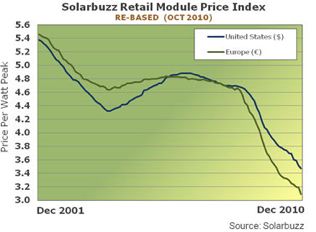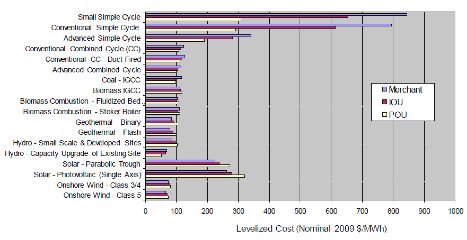What does renewable energy cost? Isn’t it still more expensive than fossil fuel electricity? Way more?
In a word: no.
A recent Los Angeles Times article typifies the confusion on this issue, misreporting significantly the results of a draft report issued by the California Public Utilities Commission (CPUC) in 2009. The article stated that achieving incoming governor Jerry Brown’s vision of 33% renewables by 2020 would cost Californians $60 billion. The article also stated that this goal would require a 14.5% electricity rate hike.
Setting aside the fact that it was actually Gov. Schwarzenegger who put in place the 33% mandate with a 2009 executive order, let’s look at these numbers in more detail.
The CPUC’s draft report was never completed and the updated analysis was instead shunted to the long-term procurement proceeding (R.10-05-006), which guides utilities in their long-term power planning. New numbers will be coming out soon, showing dramatic reductions in wind turbine and solar panel costs since the 2009 draft report was issued.
The $60 billion figure (actually $58.6 billion) from the report is the total expenditures required for all electricity investments by 2020 -- not just the cost of achieving the 33% renewables mandate.
The 14.5% rate hike is the projected hike resulting from the report’s “high distributed generation” scenario, which relies primarily on smaller solar projects to meet the 33% mandate instead of larger projects and other technologies, such as wind and geothermal power, which are cheaper than solar. The 33% “reference case” found that a 7.2% rate hike would result from this scenario, with a total incremental investment of just $3.6 billion (a far cry from the $60 billion cited by the Times article).
More importantly, the report assumes no reduction in renewable energy costs by 2020. This has already been proven woefully wrong because costs for wind turbines and solar panels have dropped dramatically in the last couple of years. Solar panel costs, in particular, have plummeted about 30% in the last couple of years and are projected to fall even further in coming years because this industry has finally reached the point where global production is many gigawatts per year and the market is becoming saturated. This is good for consumers -- but not so good for solar producers competing for the lowest prices. The planet ultimately wins in this price battle (see Figure 1).
Figure 1. SolarBuzz retail solar price index.

Last, two additional 33% scenarios, one focusing on higher wind power use and the other on higher out-of-state energy projects, found even lower costs to ratepayers. The high wind scenario would result in just $2.1 billion in incremental investments by 2020 and the high out-of-state scenario just $1.9 billion.
But isn’t that still a lot of money? Well, yes, $2 billion is a lot of money. But it’s all relative. California ratepayers spend about $30 billion per year on electricity. So $2 billion by 2020 in additional payments (not each year, mind you, just one lump sum) is a relatively small investment to reach 33% renewables when compared to the more than $300 billion ratepayers will pay for electricity during that period.
And all of these numbers assume the validity of the analysis in the draft report.
It turns out, however, that the numbers have changed quite a bit in the year and a half since the draft report came out, as already mentioned. The report states: “Under the Solar PV Cost Reduction sensitivity, the total costs of the [High Distributed Generation] Case are very similar to the costs of the 33% RPS Reference Case.” And costs for solar PV have already come down -- in just a year and a half -- to the level of the “Solar PV Cost Reduction” sensitivity.
The California Energy Commission’s most recent levelized cost of energy report shows that renewable energy can often be cheaper than traditional fossil fuel energy. Wind power, geothermal and in-conduit hydro, in particular, are highly cost-effective. And even solar power can be cheaper when we compare the costs of peak power natural gas plants to the cost of solar energy facilities, which are reliable peak power sources (see Figure 2).
Figure 2. Levelized cost of energy from various renewable energy sources. (Source: California Energy Commission, “Comparative Costs of California Central Station Electricity Generation.”)

In sum, even if we achieve the 33% by 2020 renewable energy mandate with mostly in-state solar PV generation, it costs ratepayers a relatively small amount by 2020. At the same time, the state will see significant job growth in the renewable energy industry, reduced greenhouse gas emissions, more efficient homes and vehicles, and -- probably the most significant benefit -- Californians will be able to continue to take advantage of the boom in renewable energy around the globe.
More and more investors and other leaders are recognizing that renewable energy is the next big thing. In fact, it’s already here, and we are in the exponential elbow of the growth curve. Next 10, a California non-profit, tracks renewable energy investments into California. They find that fully 25% of all venture capital investment in California goes to “cleantech,” which includes renewable energy, energy efficiency and green transportation (see Figure 3).
Figure 3. Venture capital investments in California in cleantech. (Source: Next 10 2010 Green Innovation Index.)

And Figure 4 shows that California dominates the country in terms of green tech patents, particularly in solar power.
Figure 4. California’s share of green tech patents as percentage of U.S. total. (Source: Next 10 2010 Green Innovation Index.)
_466_249_80.jpg)
By investing in the 33 percent by 2020 renewable energy mandate, California ratepayers will see a very small rate increase by 2020 -- and will save money in the long term. At the same time, we will ensure that our state remains at the forefront of the global economy.
***
Tam Hunt, J.D., is President of Community Renewable Solutions LLC, a renewable energy consulting firm and community-scale renewable energy project developer. He is based in Santa Barbara, California.



